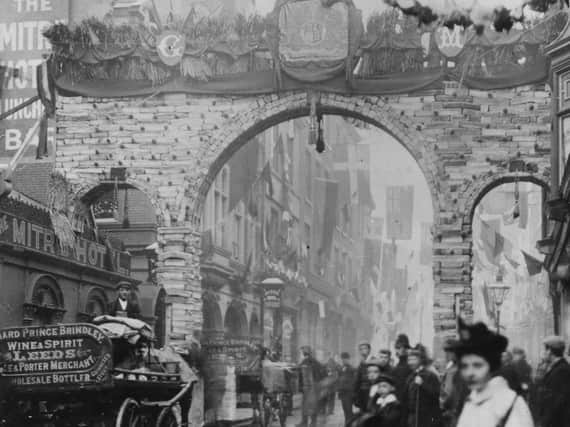How Leeds breadmakers rose to the royal occasion


Back in October 1894 the citizens of Leeds decided to build an archway made of bread in the city centre to mark a royal visit.
The structure itself spanned the width of Commercial Street near its junction with Briggate and weighed five and a half tonnes.
Advertisement
Hide AdAdvertisement
Hide AdIt was made of white, brown and spiced loaves and was created to mark the visit to Leeds by the Duke and Duchess of York - the future King George V and Queen Mary.
The bread archway was the idea of Henry Child, who ran the Mitre Hotel, to which it the temporary structure was attached.
Bread was so plentiful at the time that traders and business people who frequented the hotel came up with the idea of creating an archway built from the stuff.
It was constructed by a firm of builders, Craven and Umpleby and was overseen by an architect, Thomas Winn.
Advertisement
Hide AdAdvertisement
Hide AdAnother firm, William Silbeck and Sons, of Swan Yard, created a wooden frame structure on which the bread arch was built.
William Morris, who owned a bakery in Pack Horse Yard, was charged with baking the bread, which amounted to hundreds of loaves, the flour for which cost £20 and was paid for by one Henry Child, of the Mitre Hotel (formerly the Horse and Jockey).
It’s fair to say the project brought the whole community together. Another benefactor was Alderman Archie Scarr, who bought a hundredweight of sweets for local children. A butcher donated £20 worth of sausages (6d a pound in those days), another gave free soup.
The Duke and Duchess visited Leeds to open the Medical School and College Hall of Yorkshire College (now Leeds University). It is not known whether or not they saw the archway and if they did, what they made of it.
Advertisement
Hide AdAdvertisement
Hide AdThe bulk of the bread was in sandwich loaves, which because of their shape, made suitable ‘bricks’, while one Robert Wray, who had a confectionery business in Commercial Street, provided the huge ‘keystone’ loaf of the central arch.
When the arch was complete, it was further decorated with sheaves of corn and bunting.
The idea was to distribute the loaves to the poor after the visit but a shower of rain put paid to that plan, spoiling many of the loaves.
There appears to be some argument about whether the bread was, in fact, fit for consumption after the event but most seem to agree it was not.
Advertisement
Hide AdAdvertisement
Hide AdIt was not the only bread arch to be built in Leeds. Another was made with two arches spanning Woodhouse Lane (formerly the Leeds and Otley Road turnpike), joining to the Pack Horse Pub, to commemorate the visit of Queen Victoria to Leeds Town Hall in 1858.
*********************
A message from the Editor:
Leeds has a fantastic story to tell - and the Yorkshire Evening Post has been rooted firmly at the heart of telling the stories of our city since 1890. We believe in ourselves and hope you believe in us too. We need your support to help ensure we can continue to be at the heart of life in Leeds.
Subscribe to our website and enjoy unlimited access to local news and information online and on our app. With a digital subscription, you can read more than 5 articles, see fewer ads, enjoy faster load times, and get access to exclusive newsletters and content. Click here to subscribe. For more details on our newspaper subscription offers click here.
Thank you
Laura Collins
Comment Guidelines
National World encourages reader discussion on our stories. User feedback, insights and back-and-forth exchanges add a rich layer of context to reporting. Please review our Community Guidelines before commenting.